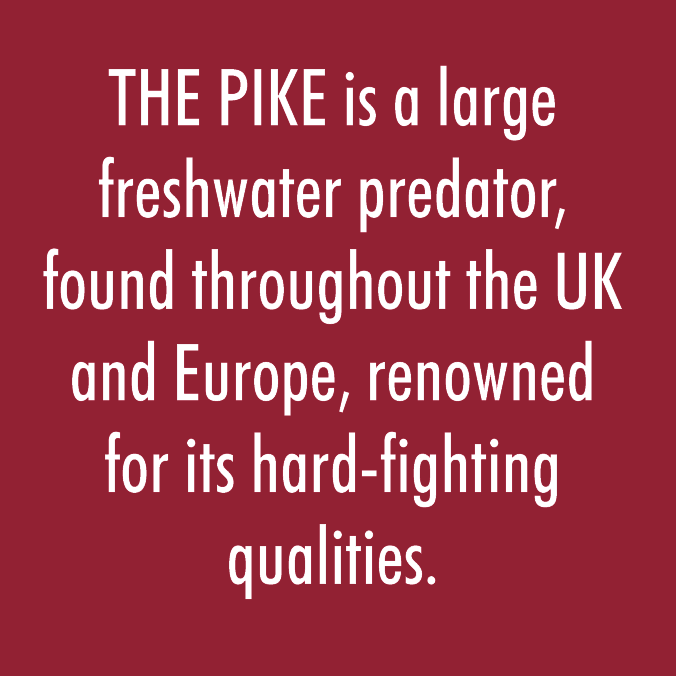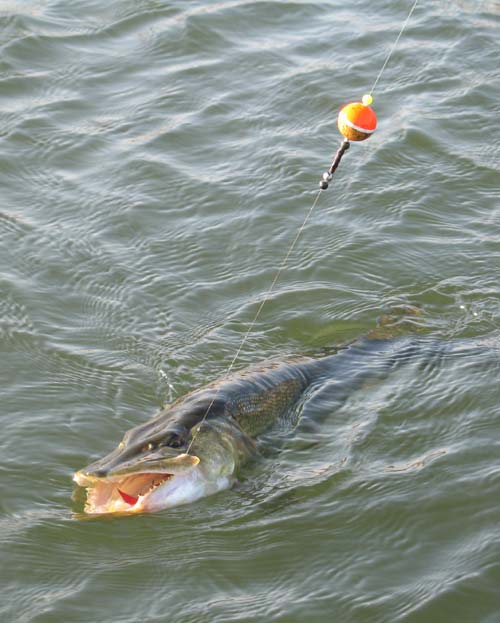The Pike – Esox Lucius
The pike is a large apex freshwater predator renowned for its hard-fighting qualities. The species is widespread throughout the UK, Europe, America and Canada. Myth and folklore surrounds pike like no other freshwater fish – but the fact remains that these ‘Freshwater Sharks’ do grow very big: in 1983, a pike of 68lbs was caught in Germany, and the British rod caught record is currently 46lbs 13 ozs, caught by Roy Lewis from Llandegfedd Reservoir in 1992. Fish in excess of ten pounds are common, whilst anglers strive to catch pike over twenty pounds. For many, thirty pounders are the fish of dreams, and forty pounders rare indeed. Pike can be found in all types of water: rivers, canals, lakes, gravel pits, lochs, loughs and reservoirs. In years past pike were misunderstood and often killed indiscriminately – fortunately, due in no small part to the Pike Anglers’ Club, fishery managers are becoming increasingly enlightened, recognising Esox lucius as both an essential part of natural water management and a valued sport-fish (please click here to view our pike conservation policy for fishery managers).
The earliest evidence of pike in the UK are one-million year old fossils found in Norfolk. The largest pike are females, male pike rarely exceeding ten pounds in weight. Pike spawn early in the spring, when water temperatures reach 9° centigrade (48°F). All pike anglers know that the so-called ‘back end’ of the coarse fishing season, the period 1 February – 14 March – provides the best chance for a very big pike. Before spawning, pike of all sizes gather together, the larger females being accompanied by many smaller males, mating lasting several days. Pike have been known to live for twenty-five years, although around eighteen seems the usual maximum longevity. Although pike will gather together, especially prior to spawning and in suitable habitats close to their prey, this is largely a solitary predator. Most of the year big pike are solo – unsurprising, perhaps, given their cannibalistic tendencies. Interestingly, pike are also recognisable due to each fish’s unique markings. This means that it is possible to recognise repeat captures. Like other creatures, these markings and colourings vary from habitat to habitat – ensuring that the pike’s camouflage is perfectly suited to its environment. Body shapes are also different: river pike are invariably long, lean and fit, due to swimming against current, whereas still-water, particularly those from trout reservoirs, are much shorter and fatter.
Pike will lie in ambush, against submerged structures, such as bridge piles, tree roots and marginal shelves. The pike is built for speed – with a long, slim, body, and large tail, ventral and dorsal fins grouped together. One swipe of the pike’s tail moves it very quickly – as any passing prey discovers all too suddenly! In addition to lying in ambush, pike will also actively hunt prey – and, as all pike anglers know – often feed to a set pattern at given times of day. What triggers these feeding spells is unknown, but at the apparent flick of an invisible switch, pike will feed the length of a stretch of river or still-water. Small pike feed upon invertebrates until between 4 cm – 8 cm long, when they start eating small fish. Pike largely predate upon easy meals – injured, diseased, dying or dead fish, and thereby perform an essential function by reducing the chance of disease. They will also, particularly on shallow lakes and broads, take water fowl and rodents. Research in 1966 on Lake Windermere confirmed that a pike can maintain its bodyweight with an annual food intake of its own weight plus around 40%. Fish populations, as fishery scientist and former pike record holder Neville Fickling argued, are not static, however. Pike, therefore, eat the excess and do not destroy fisheries – far from it: they perform an absolutely essential natural function. Annual growth rates vary, of course, depending on the availability of food. In recent years waters stocked with trout have produced many huge pike – but this is not because the trout is more nutritious, and therefore preferential, to a roach or bream, but simply because the species is abundant. Indeed, the best pike water available – Chew Reservoir – also boats a huge head of coarse fish, which helps explain the phenomenal success of this unique venue.
Pike have traditionally been caught using live fish as bait. Today, the use of coarse and sea deadbaits, which are widely available in tackle shops, and artificial lures and even flies are enormously popular. Because the pike has many sharp teeth and fights hard, specialist tackle and unhooking techniques are, however, required. For example, hooks and bait must always be mounted on a wire trace (please click here to see our Fishing for Pike section), strong line or braid must be used, and it is essential that the angler is familiar with safe handling practice. Never, therefore, go piking without a long pair of forceps, wire-cutters and, especially if lure fishing, long-handled-long-nosed pliers. Never, ever use a pike gag (which are illegal in Scotland and will hopefully soon be so elsewhere), but by all means use a glove. Again, all of this is explained in our Guidelines. Also, pike, in spite of their ferocious appearance, are surprisingly delicate creatures – especially in summer, when water temperatures are high and oxygen levels are low. At this time of year pike require extra careful handling – please check out our ‘Guide to Summer Piking’.
All newcomers are urged to join the Club, and learn these safe practices first-hand from experienced pike anglers. The aim, of course, is to return your catch alive, well and in perfect condition – for it to grow even bigger and provide another, lucky, angler with enjoyable sport.


